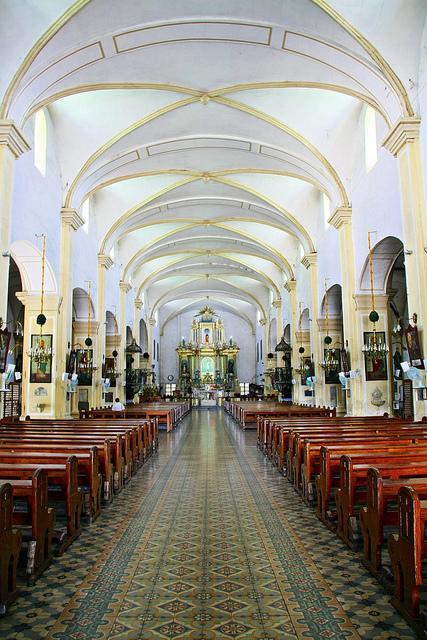
One of the amazing historical sites in Vigan, St. Paul Metropolitan Cathedral, popularly known as Vigan Cathedral, is an old church in Ilocos region located at the front of Plaza Salcedo and beside Plaza Burgos.
The first Vigan Cathedral was built and ordered by Juan de Salcedo, the conquistador and Founder of Villa Fernandina, now Vigan, in 1574. It was originally made of wood and thatch. It features neo-gothic and pseudo-Romanesque motifs. It was re-constructed in 1641 and completed its present baroque-style building in 1800. Its bell tower stands separately in Plaza Burgos. The bell tower is about 25 meters high and it is surmounted by a large bronze weathercock that is said to symbolize St Peter. It only became a cathedral when the seat of the Diocese of Nueva Segovia was transferred from Cagayan to Vigan in 1758.

Saint Paul Cathedral is one of the landmarks of Philippine Catholicism and a pride of Northern Luzon. Its interior is admired by many visitors. It has a main altar with silver-beaten panels. The facade features Chinese lion dog ornaments and above the main doorway is an alcove depicting the conversion of St. Paul. The Fu dogs design carved above its outermost doors is a testament to Vigan's strong Chinese heritage.
The view around the Saint Paul Cathedral
Close to the right of the Cathedral is the Episcopal Palace where the bishop resides. West of this building is the Rosary Academy, the school where the daughters of the Vigan aristocrats study.
Across the street, left of the Cathedral is the Vigan Diocesan Seminary. The building of this more than a century old institution was once the headquarters of the revolutionists. The museum of Natural History of the Seminary is also located in that area. At the left of the Seminary are the Periculture Center and the Vigan Municipal Hall. Across the street, on the west, is the Northern Luzon Junior College of the University of the Philippines.
Plaza Salcedo is a park in front of the Cathedral. It is made in honor of the discoverer of Vigan and the first Spanish Encomendero. It is surrounded by the most important public and private buildings in the community. Another park is the Plaza Burgos where a monument stands to the memory of Vigan's noblest hero, Padre Jose Apolonio Burgos, a martyr of Bagumbayan. The atmosphere of the place has a close similarity to Manila's Walled City, Intramuros, because of the buildings built during the Spanish era.
Travel to Vigan
By Air: Domestic flights via SeaAir leave Manila twice a week for Vigan City, Fridays and Sundays at 2:30 PM. Domestic flights leave Manila daily for Laoag City in Ilocos Norte, which is an hour and a half by bus or arranged vehicles to Vigan. The city can be reached from Laoag City via Farinas Transportation, Maria De Leon Bus Lines, RCJ Bus Lines, F. Franco Trans, Auto Bus, Florida Transit, and Partas Bus.
By Land: The 408-kilometer stretch from Manila to Vigan City is a comfortable eight-hour ride along the scenic Manila-Ilocos Highway. Air-conditioned Partas Bus, Dominion Bus, Aniceto Bus, and Viron Transit ply the Manila-Vigan route regularly.
Getting Around: The best way to explore Vigan is on foot; the city center is small yet full of excitement. Experience a calesa ride around Vigan at P150.00 per hour.
Accommodations
My Vigan Home Hotel is located at 14 Plaridel corner Bonifacio Streets, Vigan (Ilocos Sur), Ilocos Region, Philippines 2700.










